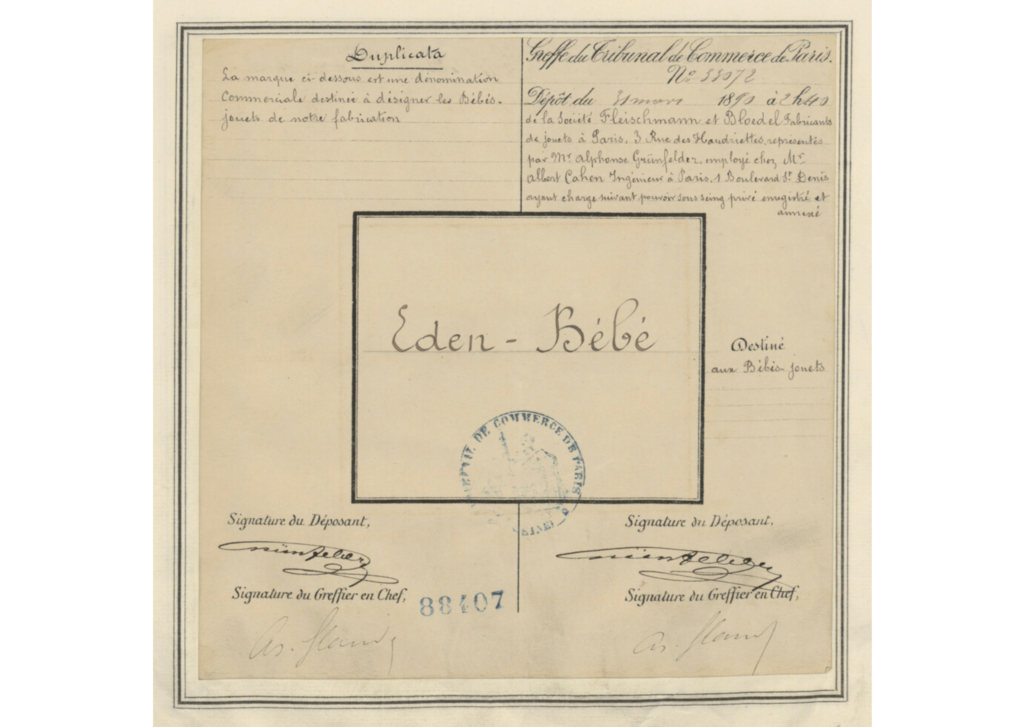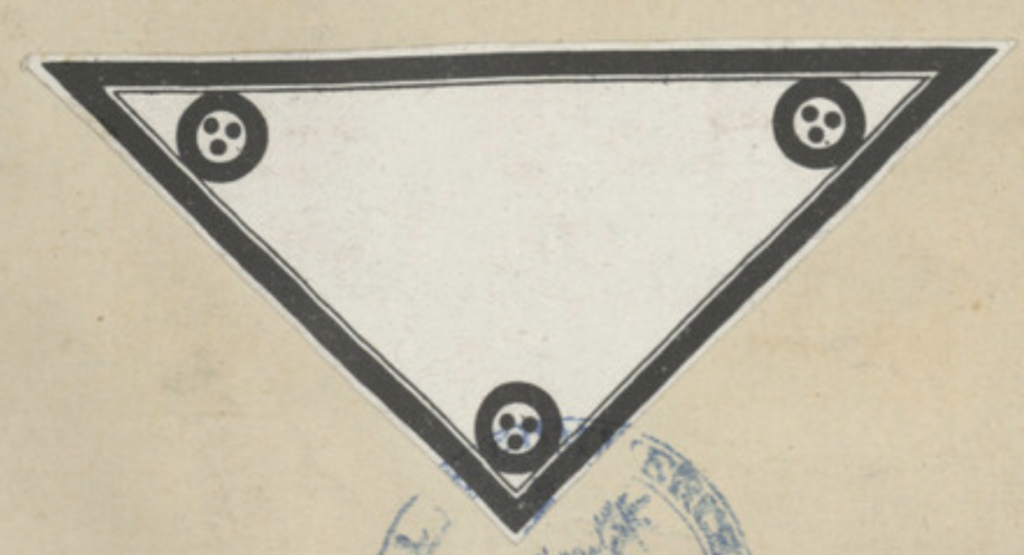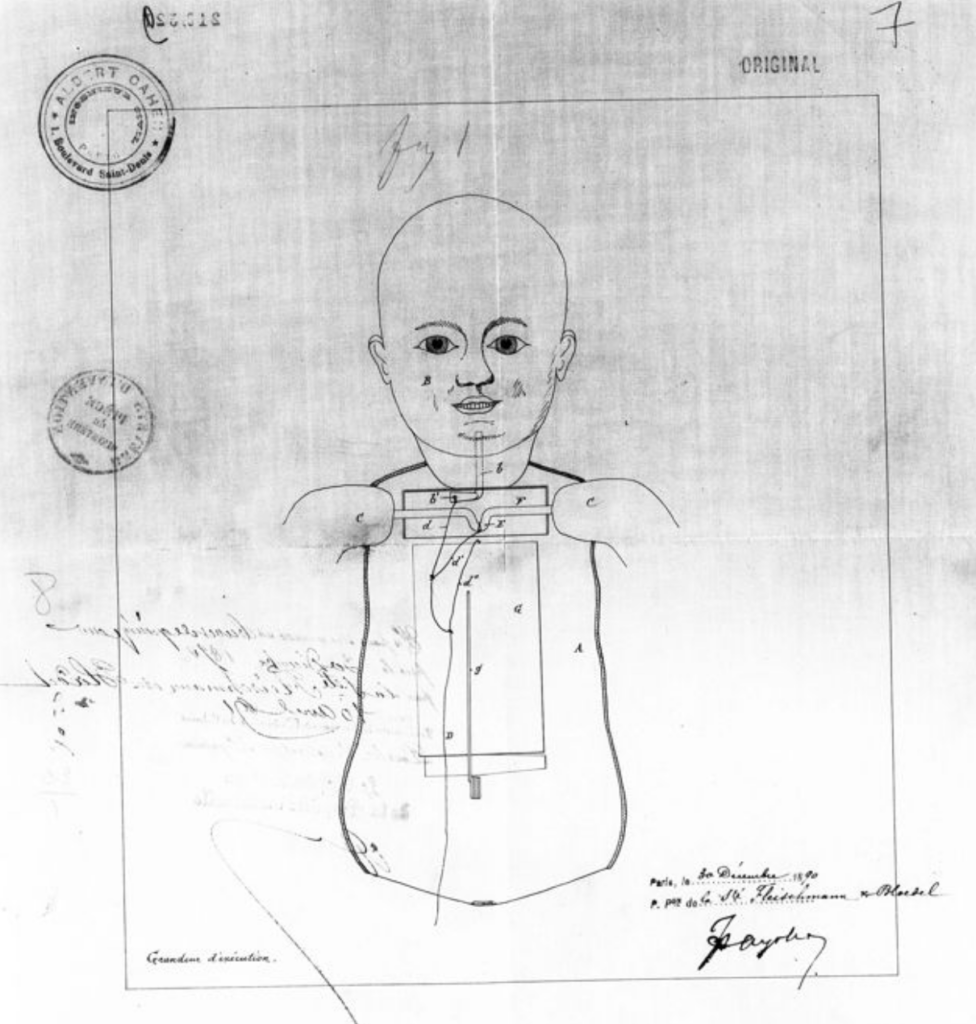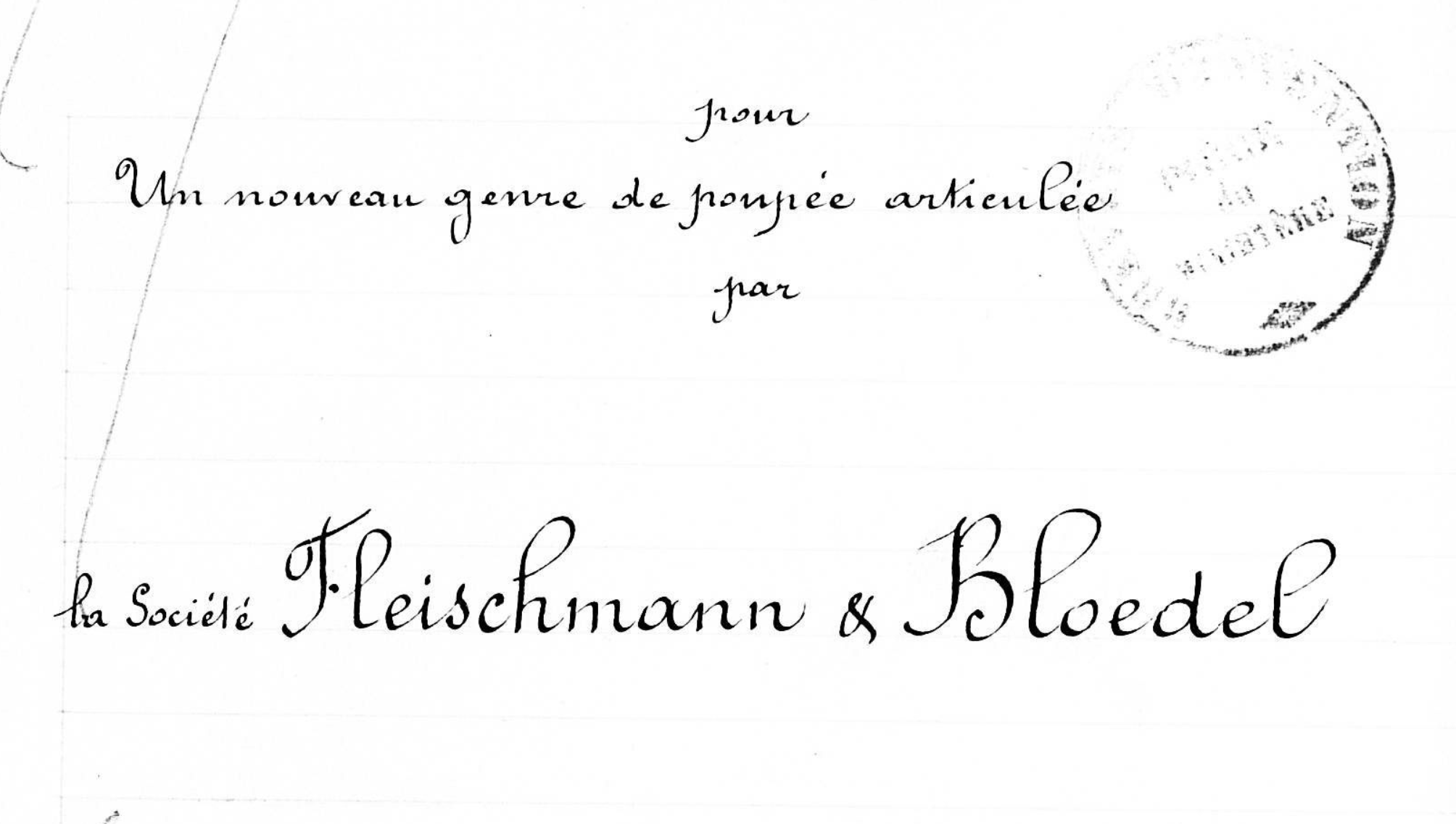Trademarks
Eden Bebe
This same year they registered their word trademark for “Eden-Bebe” using the address of 3 Rue des Haudriettes represented by Mr. Alphonse Grunfelder and Mr. Albert Cahen. The registration document explained the trademark was a commercial name intended to designate the baby toys of their manufacturing.

The Annuaire-almanach du Commerce announces the Eden Bebe factory in 1891 at the 119, rue de Montreuil address. The further say, “FLEISCHMANN & BLOEDEL, of Fuerth (Bavaria), sample counter in Paris, Haudriettes, 3, articles from Germany, toys and bazaar articles; for fixed prices, specialty of undressed and dressed babies(dolls) , factory of L’EDEN-BÉBÉ, rue de Montreuil, 119.”
They later registered the Eden Bebe trademark in 1905 under their new company name of La Société Française de Fabrication de Bébés et Jouets that formed in 1899. Read more about that below.
Triangle Trademark

In 1903 the firm registered a trademark of an upside down triangle with three button in each corner.
In 1885 an announcement for Fleischmann & Bloedel appeared in a Bavarian newspaper which read (translated), “The merchants Salomon Fleischmann and Johann Blödel, both from here, have, since January 1st of the month, taken on the merchant Anton Fleischmann from here as an additional partner in their toy store, which exists under the name Fleischmann & Blödel and has its headquarters here and which they operate as a general partnership.” They granted Anton Fleischmann power of attorney on January 1 of 1886.
Patents
The German newspaper “Chronicle of the City of Fürth” announced the firm established a doll factory in September of this year at Königswarterstrasse 11.
Not in line with the doll industry, Fleischmann & Bloedel’s first patent was for a baffle ball game system. The following year in 1890 they patented a system for stopping elastic or non-elastic links, used for assembling the joints of the limbs of baby toys.
1890 Fleischmann & Bloedel Patents
System for Assembling the Joints
The first patent #204739 in 1890 presented a system for stopping elastic or non-elastic links, used for assembling the joints of the limbs of baby toys.
Crimped Wire System
The next patent #204800 presented a crimped wire stop system for elastic or non-elastic ties used in the joints of limbs on the body of toy babies. The third patent improved upon or added to patent #204800
A New Kind of of Articulated Doll Patent
On December 30, 1890 Fleischmann & Bloedel filed a patent #210529 in France for a new kind of articulated doll. The patent gives the address of Paris (75056) 1, boulevard Saint-Denis. It had a life span for 15 years.
They improved upon or added to this patent in 1891. The Revue Industrielle listed announced an addition to the patent, “S. 210.529. Société Fleischmann et Bloedel, 30 déc. 90. — Poupée articulée.”

1892 Patent
Then in 1892 Fleischmann & Bloedel received patent #221685 for unbreakable clay for making dolls.
The JOURNAL DES PAPETIERS EN GROS ET EN DÉTAIL in December 1892 mentions the firm’s unbreakable paste for dolls and a magic mirror.)
The same journal includes a recipe by their firm for making an unbreakable doll head. In the article they use the French word pite for “head.” Translated it reads as:
Unbreakable Pite for the manufacture of dolls
By the Company Fleischmann and Bloedel, in Furth (Bavaria).At present, doll manufacturers use, in the preparation of their doughs for the manufacture of dolls, different substances, such as flour, waste skin, sawdust, cement, boiling water, etc., and the doughs generally obtained by means of these substances and the processes used would not appear to give satisfactory results from the point of view of the consistency, solidity, homogeneity and fineness of the subjects which they reproduce.
With the aim of realizing these different advantages, the inventors have imagined introducing into their mixtures the substance known under the name of skin glue.
By means of this addition, a dough would be obtained which is irreproachable in all respects and presents all the qualities enumerated above.
The proportions of the mixture of substances employed in this new process are as follows:
Flour 1 kg 500
Skin waste. 5 kg 500
Sawdust 16 kg
Portland cement 0 » 500
Hide glue 6 kg 500
Together. 30 kg 500The preparation is as follows: the hide glue is brought to the boil and mixed with the flour and cement, then the skin waste and sawdust are added. After carefully kneading all these materials, the mixture would constitute a fine and binding paste, eminently suitable for moulding.”
Journal des papetiers en gros et en détail, des imprimeurs et des libraires, des relieurs et des cartonniers. Chambre syndicale du papier. . 1892-12-01. (pages 214-215).
1894 Fleischmann & Bloedel Patents
1894 Automaten Patent

The Bulletin des lois de la République française (Bulletin of the laws of the French Republic) announced in 1896 patent #239738 filed in 1894 for a walking-automaton mechanism with combined eccentrics, for dolls, babies and other similar toys.
The Civil Engineer: journal of application and popularization of the most recent discoveries in 1895 adds more details by saying (translated), “It consists of a barrel spring movement which sets in rotation an axis on which are wedged two eccentrics at 180″, making each thigh oscillate alternately around a fixed axis by means of a sliding lever at the same time as by means of a second lever the corresponding leg oscillates around an axis fixed relative to this thigh.”
1895 Speaking Device Patent
The Munich’s Latest News announced in 1895 a new patent by Fleischmann & Bloedel in Germany for a doll with a speaking device.
1904 Toy Darts Patent
In 1904 they registered a patent #341969 for the improvements of toy darts.
Fleischmann & Bloedel Factory Fires
In October of 1892 a fire occurred at their factory at 119, rue de Montreuil in Paris that employed 300 workers inside and 700 workers outside who all lost their jobs. But that wasn’t their first fire. They had a fire in a German location as well and put a thanks to the local fire brigade for the help in the event back in 1890.
The Curious Growth of Fleischmann & Bloedel
La Réforme Sociale, published in 1892, including interesting derogatory comments regarding the growth of the Fleischmann & Bloedel business as it began to threathen it’s French rivals:
“Finally, large-scale industry: Montreuil-sous-Bois, the chosen home of Parisian babies, the factory at 59 rue de Paris, the Jumeau factory, the factory at 60 rue des Écoles, the rival, the Danel factory, the Stciner factory, rue d’Avron, finally in a slightly lower category, the large Bébés-Charmants factory, the Pintel factory, 52 rue Bichat, behind the Saint-Martin canal, and above all the Fleischmann and Blcedel factory, at 119 rue de Montreuil, towards the Barrière du Trône, the German factory, which is gradually ruining its rivals, is expanding with extraordinary rapidity and is certainly the most curious phenomenon of foreign competition to have been established in the heart of Paris. But here again, the purity of the industrial type, the large industry as presented by weaving, spinning, blast furnaces, is never encountered.
The large workshop, whatever the surfaces it covers, always remains a bit of a collective factory; branching out its workshops into rooms, populated by workers and subject to the “sweating system”, for clothing, cardboard, even decoration at the Fleischmann factory which, in this, seeks to acclimatize a use of Furth and It results that everywhere, in each of these three categories of workshop, a principle remains immutable, an irreducible element: the worker; a raw material always used: cardboard binding. So we will first concentrate our attentionNuremberg unknown in Paris on a small workshop and a family of cardboard molders, and from there we will move towards the large doll industry, a category of high luxury (Jumeau), a category of junk (Fleischmann).”
La Société Française de Fabrication de Bébés et Jouets
In 1899 Fleischmann & Bloedel formed the SFBJ or la Société française de fabrication de bébés et jouets” taking over many of the larger French doll manufacturers such as Jumeau, Bru Jeune, and Rabery.
That year the French publication Lectures Pour Tous (Readings for all) expressed the monopoly take over kind of like this: “The manufacture of dolls in France is entirely in the hands of a company whose members share the dividends; it is the Société Générale et Anonyme du Bébé Français, Bébé Bru, Bébé Géant, Bébé Jumeau, Eden Bébé, all these babies now have only one corporate name: that of the Bébé Français. This powerful association alone currently employs a staff of more than 2,000 people.”
1902 Comment
The manufacture of dolls in France presents this particular case, that it is entirely in the hands of associates grouped in a General and Anonymous Society of the French Baby. Almost all the doll factories have been bought by it, and it is now a real monopoly, because no house could compete with this powerful association. There is no longer a Baby Bru, a Giant Baby, an Eden Baby, a Twin Baby: there is only the French Baby, manufactured in concert by all these associated houses who share the dividends of the operation. The different babies continue to be born in their old factories; They all go to get dressed at the central dressmaker-milliner in the Picpus district, at the end of the Montempoivre path, in this old district of Paris that seems to be the countryside. There they cut, they sew dresses and hats, and these young ladies the dolls leave this large wardrobe for Paris and the provinces, in hundred crates of one hundred kilograms every day. The staff employed by this company is about two thousand people. It makes eighty thousand dolls annually, the prices of which vary from eighty centimes to nine hundred francs. (Exposition universelle internationale de 1900 à Paris. Rapports du jury international. France. Ministère du commerce, de l’industrie, des postes et des télégraphes. )
Fleischmann & Bloedel Addresses
They announced in 1882 a new address for the German location in Furth at Gebhardtstraße Ur. 19 opposite the upper freight hall.
Fleischmann & Bloedel advertise their doll factory in the Address and Business Manual of Fürth making the announcement 1889 (translated), “Doll factory. Fleischmann & Blödel (doll factory), Gebhardtstrasse 19. From May 1, 1889 at Göthestrasse 4. Owner: Blödel, Jean. Fleischmann, Salomon. Fleischmann, Anton.” They also advertised their business for toy exports. They also advertised previously in the same publication in 1886.
The Annuaire-almanach du commerce, de l’industrie, de la magistrature et de l’administration from January of 1889 gave the listing, “Fleischmann et Bloedel, mannf. de jouets, rue des Haudriettes, 3.”
The Paris-adresses: general directory of industry and commerce in 1897 listed them as, “Fleischmann et Bloedel, Turbigo, 50.”
The 1909 Official Address Book for the Leipzig Trade Fair gave their listing as (translated), “Fleischmann & Bloedel Nachf., J. Berlin, Fürth i. Bay., manufacture of soft and hard stuffed animals. — O.- V. Peters- Str. 24, 1st floor (Greenlanders), Room 11.”
The 1910 Leipzig Trade Fair Addressbook listing reads, “Fleischmann & Bloedel Nachf., Fürth. — Grimm. Str. 13, III”
In 1911, “Fleischmann & Bloedel Nachf., J. Berlin, Fürth (Bavaria), Nürnberger Str. 129, manufacture of soft toys and caricature dolls. — O.-F. and JZ. Grimmaische Str. 13, III (Messpalast Hansa), right, stand 258 a/d.”
The 1914 listing in the Leipzig Addressbook read, “Fleischmann & Bloedel Nachf., J. Berlin, Fürth (Bayern), Nürnberger Str. 129, MB” Fabrikation u. Grosshdlg in Porzellan-, Kurz- u. Spielwaren für Frankreich u. Übersee. — OV. — Messwohnung: Hotel Stadt Rom, Georgi-Ring 12. Zugleich Aussteller. Export.” Another 1914 Leipzig listing reads, ‘Fleischmann & Blödel Nachf. J. Berlin, Fürth. — Dresdner Hof, Neumaikt, Std. 125/6. [Filztiere u. -Puppen.]”
Volume 41 of the 1916 addressbook for the Leipzig Trade Fair listed, “Fleischmann & Bloedel Nachf., 4. Berlin, Fürth. — Dresd. Hof, III.”
Further reading:
